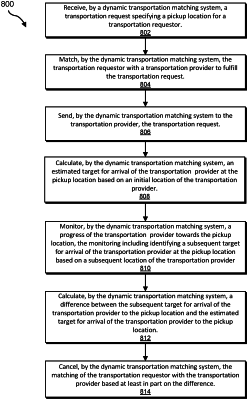| CPC G06Q 50/30 (2013.01) [G06N 20/00 (2019.01)] | 20 Claims |

|
1. A computer-implemented method comprising:
receiving, by a dynamic transportation matching system from a computing device of a requestor, a request for transportation specifying a pickup location for the requestor;
matching, by the dynamic transportation matching system, the requestor with a provider for completion of the request;
sending, by the dynamic transportation matching system to a computing device of the provider, the request for transportation;
calculating, by the dynamic transportation matching system, an estimated target for arrival of the provider at the pickup location based on an initial location of the provider;
monitoring, by the dynamic transportation matching system, a progress of the provider towards the pickup location, the monitoring including identifying a subsequent target for arrival of the provider at the pickup location based on a subsequent location of the provider;
calculating, by the dynamic transportation matching system, a probability of a cancellation of the matching of the requestor with the provider based on the progress of the provider towards the pickup location by:
determining that the pickup location is part of a geographic cluster;
generating a data-driven model using machine learning;
tuning the data-driven model for the geographic cluster; and
using the data-driven model associated with the geographic cluster to calculate the probability of the cancellation of the matching; and
cancelling, by the dynamic transportation matching system, the matching of the requestor with the provider based at least in part on:
accessing the data-driven model associated with the geographic cluster to determine a threshold value for the probability of the cancellation of the matching; and
comparing the probability of the cancellation of the matching of the requestor with the provider to the threshold value.
|